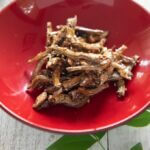
Japanese people eat Tazukuri (Candied Baby Sardines) as part of Osechi Ryōri – the traditional New Year’s feats. Dried baby sardines are coated with soy-flavoured glaze. It is very sweet and sticky, as most candied foods are.
Don't forget to see the section 'MEAL IDEAS' below the recipe card! It gives you a list of dishes that I have already posted and this recipe that can make up a complete meal. I hope it is of help to you.
- 50g/1.8oz dried baby sardines (note 1)
- Oil to brush a tray (note 2)
- ½ tsp roasted white sesame seeds (optional)
- 2 tbsp sugar
- 1 tbsp cooking sake
- 1 tbsp mirin
- 1 tbsp soy sauce
-
Place a sheet of baking paper in a large frying pan (note 3) and heat over low heat.
-
Put the dried sardines onto the pan with the baking paper and roast them on low heat. Continue to move them around and toss them occasionally so that the sardines are evenly roasted.
-
When you start hearing a faint crackling sound from sardines (after about 8 minutes, note 4), turn the heat off.
-
Transfer the sardines from the pan to a plate by picking them up, instead of sliding the sardines from the paper to the plate (note 5).
-
Put all the Soy Glaze ingredients in a small saucepan (about 15cm/6” in diameter, note 6) and bring it to a boil.
-
Reduce the heat to medium and continue to cook. It will thicken and the liquid will become bubbly.
-
When the large bubbles start rising (see the step-by-step photo in the post), remove the pot from the heat (note 7), then put the roasted sardines in immediately.
-
Mix the sardines gently but thoroughly ensuring that all sardines are fully coated with the glaze.
-
Spread the candied sardines on the oiled tray and let them cool down.
1. Dried sardines to make Candied Baby Sardines are called ‘gomame’ (ごまめ) or ‘tazukuri’ (田作り). The size of the fish is about 5cm/2" long. The fish is not anchovies that are often sold as ‘niboshi’ (煮干し) to make dashi stock.
I could not find gomame in Sydney, so I substituted it with nibling niboshi, which I purchased from a Japanese grocery store. It came in a pack (see the photo in the post).
You can also make Tazukuri with Korean dried anchovies. Korean dried anchovies come in a variety of sizes. You need to use mid-size anchovies of 4-5cm/1½-2" long.
2. If you are using a non-stick tray, you probably don’t have to oil your tray. My tray was non-stick, but I still oiled it just in case.
3. Roasting sardines on baking paper allows you to dry the sardines evenly. By having the paper, the fishy smell does not get to the frying pan, and you don’t need to wash the pan after use.
4. The cooking time varies depending on the thickness of your frying pan and the strength of the heat.
5. While roasting the sardines, piece of skins and heads come off the sardines. You don't want to include these pieces mixed into the glaze.
6. If your saucepan is too wide, the liquid spreads very thinly, resulting in the liquid evaporating and caramelising too fast. It becomes a bit difficult to control the caramelisation of the glaze. It is also difficult to coat the sardines with the glaze when the glaze is thinly spread.
7. The timing of removing the pot of Soy Glaze from the cooktop is quite important. If it is too early, the glaze is watery, if it is late, the glaze becomes too hard to coat sardines with. The right timing to remove the pot from the cooktop is when you see large bubbles start to rise in the pot.
Do not leave the pot on the hot cooktop as the glaze thickens further and becomes too hard.
8. Tazukuri (Candied Baby Sardines) keeps about 10 days in the fridge. You can also freeze it for 1 month. When serving after chilling it, leave Tazukuri at room temperature for a while to let the glaze soften.
9. Nutrition per serving, assuming 8 servings.
serving: 19g calories: 75kcal fat: 3.6g (6%) saturated fat: 0.3g (1%) trans fat: 0.0g polyunsaturated fat: 0.7g monounsaturated fat: 2.6g cholesterol: 2.1mg (1%) sodium: 270mg (11%) potassium: 85mg (2%) carbohydrates: 4.6g (2%) dietary fibre: 0g (0%) sugar: 4.2g protein: 5g vitamin a: 0% vitamin c: 0.1% calcium: 0.6% iron: 0.6%